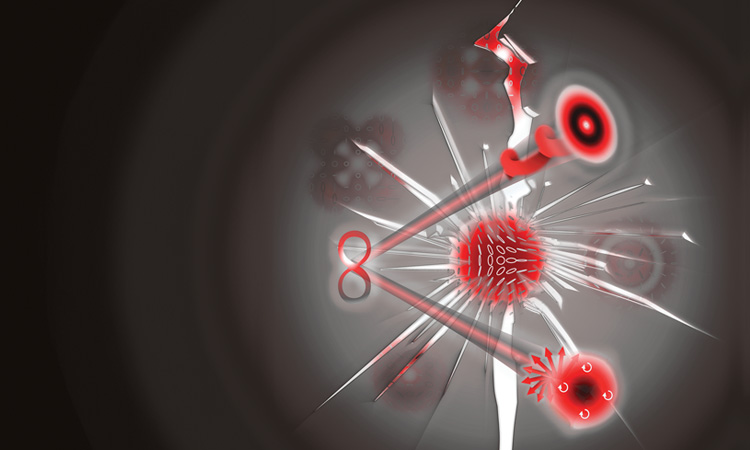 Recent advances are breaking the barriers between classical and quantum light. [I. Nape]
Recent advances are breaking the barriers between classical and quantum light. [I. Nape]
Over the past century, advances in classical and quantum optics have shaped developments in telecommunications, sensing, manufacturing, medical imaging and many other areas. Driving these advances has been the sophisticated control of lasers and individual photon states, facilitated by the development of tools that manipulate individual degrees of freedom of light such as time, frequency, spatial, path and polarization.
This meticulous control allows for the structuring of complex light states into bright beams or even at the single-photon level, enabling a wide range of applications. In the case of bright laser beams, optical fields can be finely tailored for applications like high-precision laser cutting or particle trapping. At the single-photon level, the unique features of quantum mechanics allow secure and unbreakable communication links resistant to eavesdropping and interception.
The physics of classical and quantum light overlap somewhat, due to the wave-like theories that describe both. Yet the types of correlations that can be produced differ drastically. Quantum nonlocal correlations, inherent to entangled photons, enable the measurement outcomes of one photon to influence those of another, regardless of the distance between them. Such an effect, which cannot be produced by any classical system, has been demonstrated countless times in experiments similar to the Bell inequality violations demonstrated by 2022 Nobel laureates John Clauser, Alain Aspect and Anton Zeilinger.
However, nonseparability, a defining mathematical trait of quantum entanglement, also shows up in classical (coherent) laser beams—for example, in vector modes, where it facilitates an interplay between each photon’s polarization and spatial profile. In vector beams, nonseparability involves the interconnection between internal degrees of freedom of light, in a way analogous to the nonlocal entanglement that links spatially separated single photons in the quantum realm. Light exhibiting this interplay between the internal degrees of freedom is often referred to as nonseparable light. It is naturally produced in optical fiber, can be created in carefully designed laser cavities, or may be tailored externally using interferometers, liquid-crystal devices or metasurfaces.
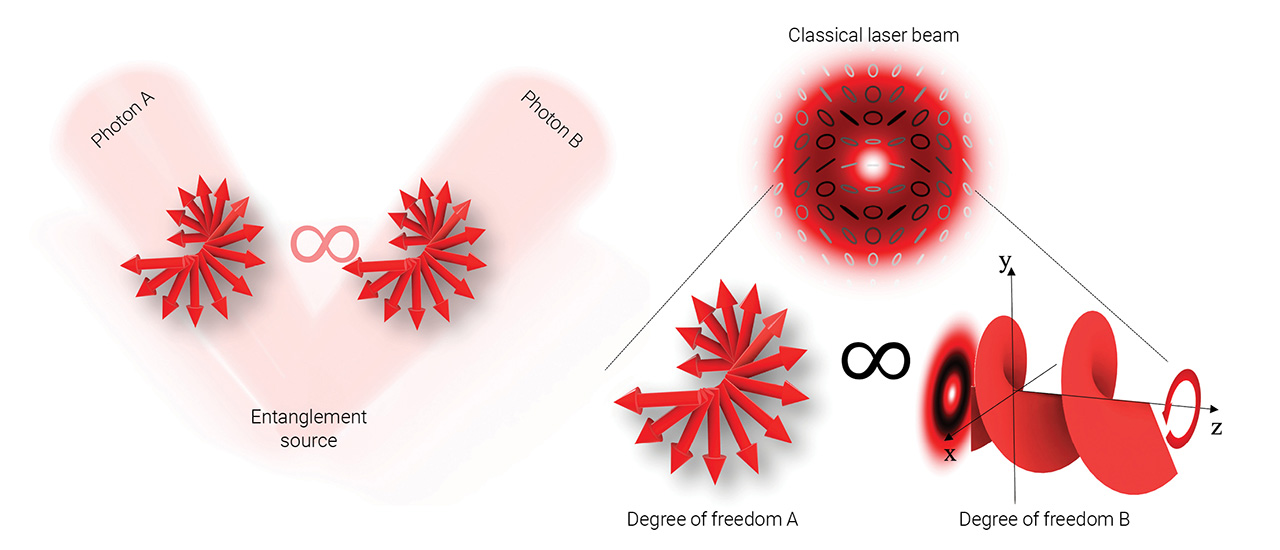 [Enlarge image]In nonlocal quantum entanglement (for example, of polarized photons), correlations shared between spatially separated photons cause them to affect each other’s measurement outcomes in ways that can’t be reproduced by classical light. In classical nonseparable light (for example, vector beams), the degrees of freedom—in the case shown, polarization and spatial—can be entangled.
[Enlarge image]In nonlocal quantum entanglement (for example, of polarized photons), correlations shared between spatially separated photons cause them to affect each other’s measurement outcomes in ways that can’t be reproduced by classical light. In classical nonseparable light (for example, vector beams), the degrees of freedom—in the case shown, polarization and spatial—can be entangled.
While the analogy between entanglement and nonseparable light has piqued curiosity and sparked debate, it has recently opened up many opportunities for potential synergy. For example, intriguing features such as channel state duality in quantum systems are mirrored in vector beams, allowing quantum channel dynamics to be studied using classical light. The invariance of entanglement, meanwhile, grants nonseparability of vector modes immunity against aberrations, allowing for error-free communication. On the other hand, particle-like topologies in vector beams are now realized as entities in nonlocal hybrid entangled systems—another hint that many features are transferable between classical and quantum states of light.
While the analogy between entanglement and nonseparable light has piqued curiosity and sparked debate, it has recently opened up many opportunities for potential synergy.
This article delves into the distinctions between local classical and nonlocal quantum entangled light, unraveling their obscure yet complementary attributes and examining how they may benefit one another. We explore in particular how nonseparability, the analogue of quantum entanglement, replicates itself in classical light and the benefits this insight can bring. We also discuss how traits from classical beams can be transferred back to hybrid entanglement, entangling distant photons with independent degrees of freedom to create particle-like topologies that were initially realized with classical laser beams.
Of classical and quantum light
Classical and quantum light differ in many ways. In classical light—that is, light generated from coherent lasers—the light field consists of many photons, all with a consistent phase relation that lets them behave as a single coherent unit. While we can be certain about the phase of coherent laser beams, the photon number fluctuates and is given by a Poisson distribution. We can know the average number of photons, but not the exact number at a given time. Despite this subtle link to quantum uncertainty, the physics that governs the macroscopic properties of coherent light beams follows from Maxwell’s equations and electromagnetism. From this, it is possible to predict phenomena such as the superposition principle for light waves and interference effects in double-slit experiments—all of which are classical.
Down at the single-photon level, superposition and interference are still observed, occurring in ways similar to classical laser beams—but they are attributed to the probability waves of single photons, as though the photons become waves that interfere with themselves. While abundant experiments using beam splitters or physical slits have offered convincing evidence of quantumness, it would be hard to tell a laser beam from a single photon if the source were covered in a black box and we had access only to the interference patterns from the experiment. This is essentially because both systems are described by wave theories that have the same outcome in slit interference experiments.
Entanglement, however, clearly distinguishes between classical and quantum light. It produces effects that cannot be reproduced by any classical system, including coherent laser beams. It allows the measurement of one photon to affect the measurement of another even though the two are far apart—Einstein’s famous “spooky action at a distance.”
The first experiment to verify this phenomenon with photons was performed by Alain Aspect and colleagues, who used an atomic cascade system, in which the excitation and de-excitation of atoms facilitated the emission of polarized entangled photons. By rotating polarizers at angles prescribed by John Clauser’s adaptation of John Bell’s inequality test, it was possible to check whether the two photons had nonlocal correlations with no classical equivalent. The test could sift out, from the measured correlations, whether the system was classical or purely quantum-entangled. It has now been run using many degrees of freedom, including path, spatial modes of light, pixel-like states, time bins and even across free-space channels and satellite links.
With the refinement of measurement tools, approaches such as quantum state tomography of photons soon made it possible to determine the underlying quantum states of entangled photon pairs, thereby allowing quantification of entanglement using entanglement “witnesses” and measures. One such measure is concurrence, which quantifies the degree of entanglement in a quantum system and is commonly associated with the amount of “nonseparability” between entangled subsystems.
To understand nonseparability’s role in entanglement, consider the two polarization-defined photons produced in Aspect’s experiment. Because polarization is two-dimensional—forming two independent states, or a two-letter alphabet (A and B)—there are four possible combinations of states for the system: AA, AB, BA, BB. When the system is not entangled, besides not violating the Bell inequality, the state can be factorized or separated into the individual photons’ contributions, making them independent subsystems; that is, the photons are separable. Conversely, when the separation is not possible, then two photons have interlinked polarizations and the two-photon system is mathematically nonseparable; the state AA+BB, for example, cannot be factorized into a single product, whereas AA or (A+B)(A+B) can.
Nonseparability: Blurring the classical–quantum line
Photonic entanglement, a purely quantum phenomenon, sets a clear distinction between classical and quantum light. Yet certain classes of laser light—structured light beams—can be analogues of entangled states. And the concept of nonseparability provides the key classical–quantum bridge.
Certain classes of laser light—structured light beams—can be analogues of entangled states. And the concept of nonseparability provides the key classical–quantum bridge.
It is now recognized that nonseparability can be seen in the internal degrees of freedom of many systems, including neutrons, ions, single photons and bright laser beams, and has been demonstrated using the polarization–spatial, polarization–path, and polarization–spatial–temporal degrees of freedom. These nonseparable states have produced exotic structured light fields with intriguing propagation dynamics, unparalleled focusing capabilities and, in some cases, topological features such as knots and hopfion-like structures.
How does nonseparability manifest in such beams? Consider, for example, the polarization and spatial degrees of freedom. Light’s polarization modes resemble a two-level system akin to electron spin states. Remarkably, light’s polarization is associated with its spin angular momentum, which gives it the ability to send microscopic objects into right- or left-handed rotational motion about their axis. Each photon in the field has spin angular momentum corresponding to a right- or left-handed polarization (spin) state. We can represent all other polarizations states as the linear combinations of these two polarization spin states, and can plot them on a parameterized sphere, the Poincaré sphere—analogous to the Bloch spheres that are commonly used to represent two-level systems for qubits in quantum mechanics.
Moreover, the same can be done for the spatial degree of freedom. For example, the orbital angular momentum (OAM) of light, corresponding to donut-shaped modes with a characteristic vortex, can also be represented in a parameter space for qubits. These modes are associated with the helical twists in the wavefront of light; twisting many times and able to show right- or left-handedness. Similarly, any two twisted modes can also create a two-level (qubit) system. Accordingly, we see that the polarization and spatial components of light can be represented in a fashion similar to the description of individual qubits—except that here, the components denote the degrees of freedom of the photons.
By combining the polarization (spin) and spatial (OAM) components of classical light, we can represent degrees of freedom in light beams as analogues of particle pairs. Each degree of freedom can be treated as though it were a particle, and this can be seen mathematically from the tensor products that represent them—that is, the mathematical notation used to represent combined subsystems (or, in this case, degrees of freedom). From these products, the factorizability (separability) of the states can be assessed.
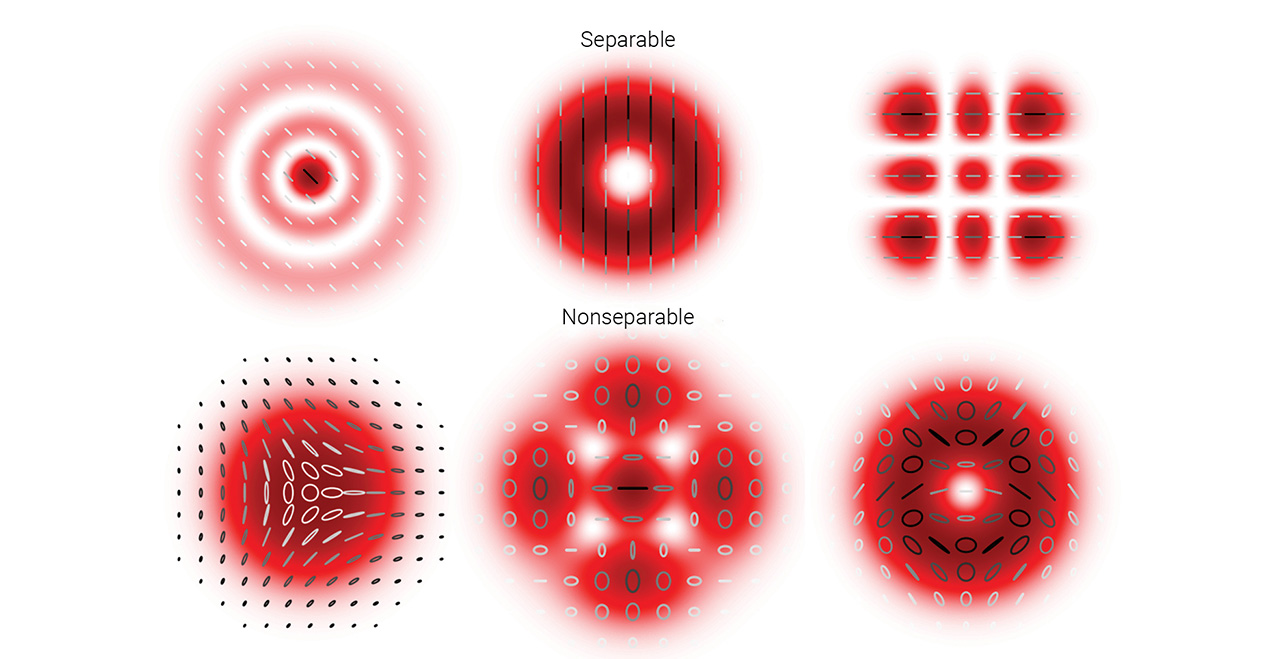 [Enlarge image]For separable (scalar) classical beams, polarization is uniform across the beam, showing separability and independence between the spatial and polarization components. For nonseparable (vector) light, polarization varies across the spatial coordinates of the beams, and the degrees of freedom are nonseparable or entangled.
[Enlarge image]For separable (scalar) classical beams, polarization is uniform across the beam, showing separability and independence between the spatial and polarization components. For nonseparable (vector) light, polarization varies across the spatial coordinates of the beams, and the degrees of freedom are nonseparable or entangled.
Just as with separable and nonseparable entangled states, it is now possible to establish combinations of polarization and spatial components of light that are completely independent (separable) or co-dependent (nonseparable). In the structured-light community, these states of light are known, respectively, as scalar beams and vector beams. Scalar beams, like separable (nonentangled) quantum states, are each characterized as factorizable products of the spatial and polarization components, showing that they are independent quantities of the field. They are characterized by uniform polarization fields. Vector beams, analogous to nonseparable quantum entangled states, have spatial and polarization components that cannot be written as a separable product and have characteristic inhomogeneous polarizations that vary across the beam.
Where might analogies between quantum and classical light be useful? One possible area is communications systems, where nonseparable light could potentially boost information capacity.
Entanglement metrics such as concurrence are commonly used to quantify the nonseparability of classical light with mixed degrees of freedom. Scalar beams will register a concurrence (nonseparability) value close to zero, reflecting their homogeneity in the polarization field. As polarization inhomogeneity increases, so does the concurrence value, potentially reaching a maximal value of one for a maximally nonseparable vector beam. Quantum measurement tools—Bell-like inequalities, quantum tomography and many others—can be carried over to characterize classical beams.
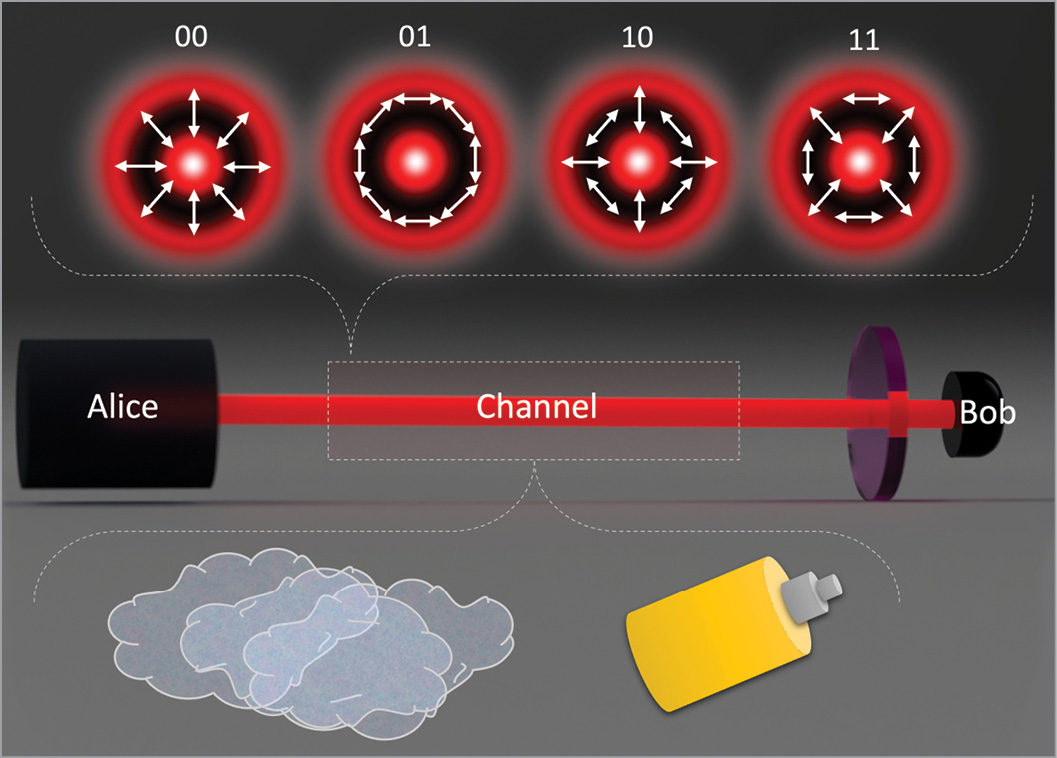 [Enlarge image]
[Enlarge image]
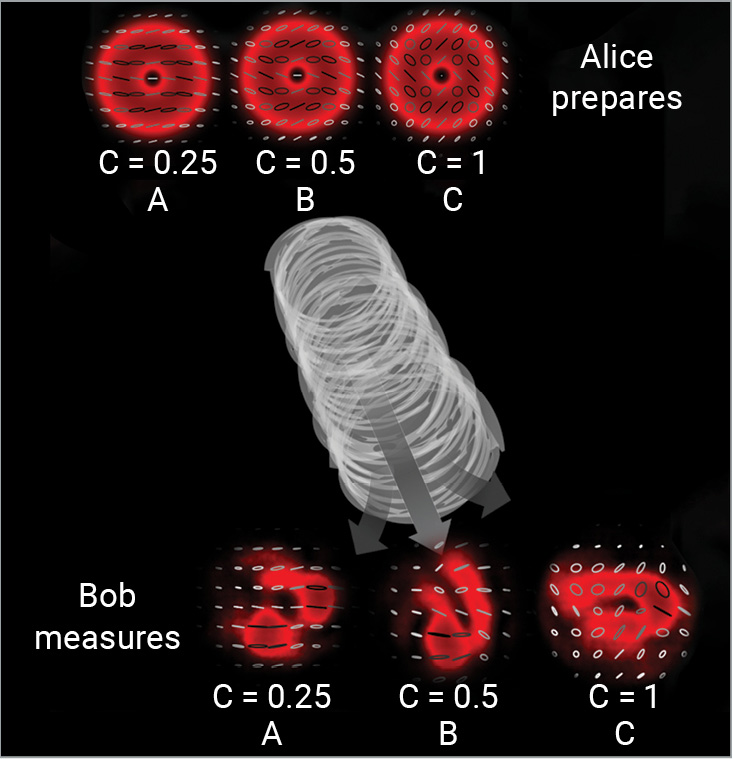 [Enlarge image]
[Enlarge image]
Creating an encoding alphabet
When nonseparable states of light are used for quantum and classical communication, a larger encoding alphabet can be formed from combining spatial and polarization encoding. Here is an example.
Putting two polarization modes, H and V, together with two spatial modes, a and b, gives rise to four combinations of polarization–spatial coupled modes, Ha, Hb, Va and Vb, similar to the binary encoding 00, 01, 10, 11. This effectively doubles the encoding capacity available using polarization alone. As nonseparable vector beams can also be formed from this combination, we can create an alphabet out of their linear combinations to create a four-level encoding scheme.
In one typical example, the TE (radially polarized) and TM (azimuthally polarized) modes, as well two hybrid electric (HE) modes—which are also natural modes of free-space and fiber channels—have been used both in classical communication multiplexing schemes and in quantum cryptography such as quantum key distribution (QKD) and secret sharing.
In classical communication, for example, G. Milione and colleagues demonstrated in 2015 that the nonseparable vector beams, when used to encode information for optical communication, can achieve 2-bit information encoding per signal with simple linear optical elements. For quantum communication, A. Sit and colleagues, in 2017, reported reaching a similar information capacity for quantum communication across a 0.3-km link using a prepare-and-measure protocol for QKD. To achieve this, the team combined four vector modes with a second mode set of scalar beams to reduce an eavesdropper’s ability to gain information about the encryption key. Such qualities can be enhanced using higher-dimensional bases.
These modes are being deployed in free space, underwater and in fiber optic channels, which tend to be noisy and distort the modes, thereby reducing their performance. Alternatively, for classical communication, the nonseparability (C), which is immune to turbulence, can also be used as an encoding alphabet, enabling error-free communication.
Utility of nonseparable states of light for communication
Where might these analogies between quantum and classical light be useful? One possible area is communications systems, where nonseparable light could potentially boost information capacity. This is due to the extensive encoding alphabet that can be derived from these light modes—there are many distinct nonseperable patterns of light to choose from. Since this type of light can be incorporated both into intense lasers and at the single-photon level, it offers utility across various communication protocols, spanning from classical to quantum communications.
In quantum communications, these nonseparable modes, encoded into single photons, can be used to distribute secure encryption keys across two parties, customarily called Alice and Bob. The increased alphabet not only increases the encoding capacity; it also enhances the security of the transmitted signals and prevents adversaries from accurately copying the signals (see “Creating an encoding alphabet,” right).
On the other hand, in classical communications, much research has gone into incorporating nonseparable light in mode-division multiplexing schemes that aim to reach information rates that can compete at the commercial scale. In both the quantum and classical regimes, researchers focus on deploying these modes in optical fiber, in free space and across satellites. However, deploying quantum and classical light in communication channels poses a significant challenge in the real world, where a variety of decoherence mechanisms—complex aberrations, turbulence, fog, rain, mode mixing and more—can limit their performance.
Intriguingly, in turbulence, nature cannot tell the difference between classical and quantum states under the effect of perturbations. In particular, when the perturbations are single-sided (acting on only one photon), entangled photons and vector beams decay similarly. Because turbulence is a phase aberration that deforms the spatial fields of photons but not polarization, a vector beam subject to turbulence undergoes the same transformation as a two-photon state in which only one photon experiences the perturbation. This means that the vector beam can be used to probe the dynamics of the channel and therefore yield information that can be used to correct the adverse effects of turbulence on the two-photon entangled state.
Other work has investigated exploiting the synergy between quantum and classical nonseparable states of light by looking at some of the invariant properties of entanglement and transferring them to vector beams. In 2022, I. Nape and colleagues, noting that entangled states are invariant to local unitaries (operations akin to rotations), showed that this may also hold true for the nonseparability of vector beams. This is because turbulence also acts like a complex rotation, altering the spatial and polarization profile of the field but not affecting the nonseparability (equivalently, polarization inhomogeneity).
This revelation marks the first time that certain characteristics of vector beams have been identified as immune to spatial perturbations. That discovery, in turn, led to an encoding mechanism that capitalizes on the nonseparability-preserving nature of spatial perturbations. In 2023, K. Singh and colleagues described an alphabet based on the level of nonseparability that could be utilized as an encoding mechanism, achieving high levels of communication fidelity while minimizing errors typically caused by environmental perturbations. This makes vector beams a promising candidate for robust, error-resistant optical communication systems.
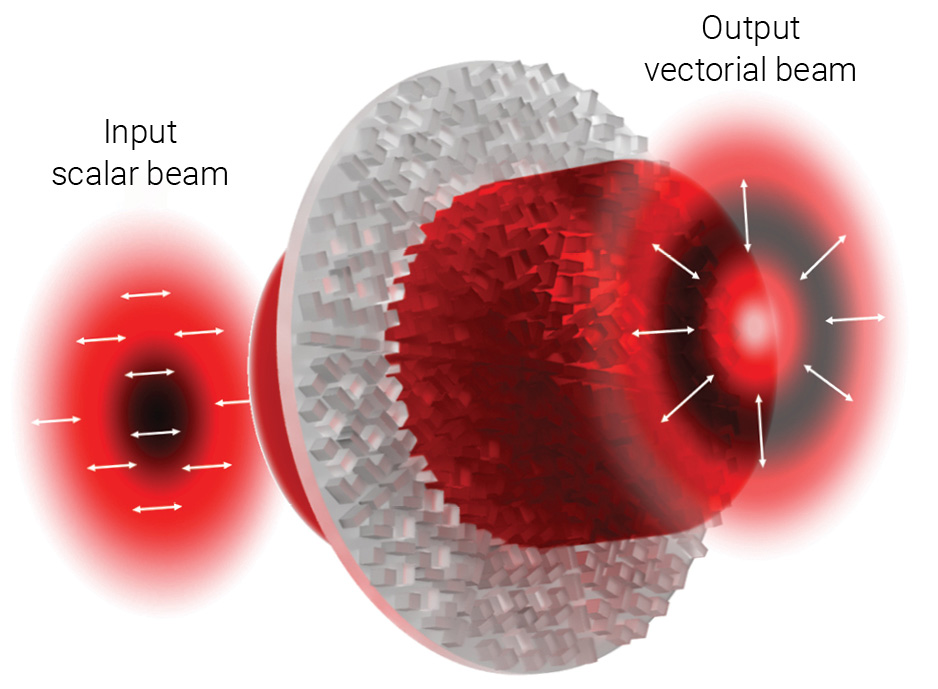 [Enlarge image]Classical nonseparable light produced from a custom optic that shapes the polarization and spatial components of light to produce a vector beam with a spatially varying polarization profile. These kinds of optics can take a scalar beam as an input and reshape it into a vector beam having a nonuniform polarization field.
[Enlarge image]Classical nonseparable light produced from a custom optic that shapes the polarization and spatial components of light to produce a vector beam with a spatially varying polarization profile. These kinds of optics can take a scalar beam as an input and reshape it into a vector beam having a nonuniform polarization field.
Generating and detecting nonseparable light
How do we produce different types of complex polarization patterns or sculpt single photons into complex polarized wavefunctions? The answer is that once we know how to achieve this in coherent laser beams, we can immediately transfer the same tools to shape single photons.
Most laboratories use programmable spatial light modulators (SLMs) within Mach-Zehnder and Sagnac interferometers that are commonly used for structured-light generation. These devices shape individual polarization modes before recombining them with beam splitters or displacers. Such setups, however, are bulky and can pose challenges due to phase instabilities (although the digital nature of the SLMs allows one to tailor arbitrary patterns on demand and at high speeds). Other methods employ devices like liquid-crystal-based q-plates through geometric phase control. In this approach, the birefringence varies spatially, with the optic acting as a waveplate at every point in the beam and thus altering the polarization locally. Subwavelength gratings (J-plates), metamaterials and on-chip solutions have provided still other, more compact beam-generation techniques.
The same generation tools can be used for detection, by harnessing the reciprocity of light and, therefore, functioning as mode-dependent filters or as an apparatus for reconstructing polarization fields. For efficient communication, most systems often require a single-shot measurement that is capable of distinguishing between different modes, analogous to how a polarization beam splitter distinguishes polarization modes by path. Devices designed for this purpose have been inspired by mode sorters, which can spatially map different twisted modes onto discrete spots of light depending on the number of twists in the light field. Vector modes can be sorted using such schemes, augmented with an additional interferometer.
These approaches tend to be alignment-intensive and physically cumbersome. To avoid this, more advanced mode sorters are being employed that leverage multiplane light conversion, in which a series of cascaded phase masks is used to achieve the mode transformations for converting a complex polarized light beam into a spot of light. This can be done with programmable spatial light modulators or cascaded metasurfaces. Such technological advances pave the way for more compact and efficient quantum and classical communication systems capable of handling the required complexity of vector mode sorting with greater ease and precision.
Separating degrees of freedom nonlocally
Clearly, one can use numerous tools to generate analogues of nonlocal entangled states by combining degrees of freedom in classical light. However, there is also a form of quantum entangled state that bears a resemblance to vector modes, involving spatially separated photons, each defined in individual degrees of freedom. Such a state is referred to as hybrid entanglement, a concept that differs significantly from entanglement between two photons sharing the same properties. Instead, each photon maintains its distinct degree of freedom.
Hybrid entanglement was used to probe the quantum world in early experiments. Stephen Walborn’s “quantum eraser” experiment in 2001, for example, combined path/spatial and polarization degrees of freedom. In this experiment, one photon from an entangled pair was sent to a double slit, consisting of slit a and slit b. The twin photon’s measured polarization state determined the path or slit that its entangled partner traversed. If the twin photon was measured with horizontal (H) polarization, the other photon passed through slit a; if the twin had a vertical (V) measured polarization, its partner passed through slit b.
In both cases, a smear pattern was observed indicating that there was no path interference. The magic occurred when the polarized photon was measured as a superposition of H and V. The entangled twin photon that traversed the slit was now forced into a superposition of both paths, passing simultaneously through both slits a and b. The resulting superposition in the paths was then observed as an interference pattern after the slits (as in Thomas Young’s classic experiment), showing that the path information had been erased.
When this experiment is adapted to include OAM (twisted light) instead of physical slits, the polarization of one photon influences the OAM state of its entangled partner, replacing the paths a and b with OAM modes of opposite-handedness or twists. This state is reminiscent of how the polarization of a classical vector mode is coupled to its spatial pattern; the difference is that the phenomenon here is nonlocal. Therefore, erasing the OAM in this case results from a superposition measurement that produces an azimuthal interference pattern for the twin (spatial) photon.
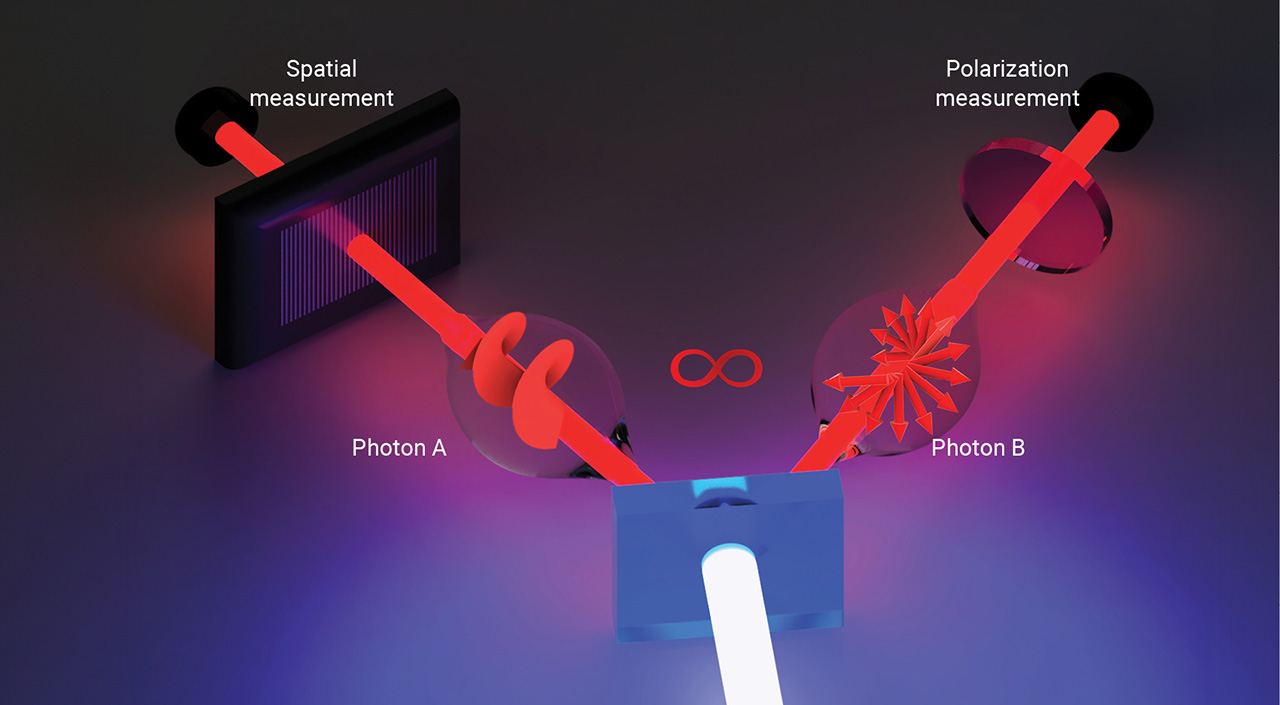 [Enlarge image]Mixing degrees of freedom nonlocally. An entanglement source generates two photons, one carrying OAM (twist) and the other polarized (spin). This is called hybrid entanglement, where the measurements are performed in different degrees of freedom—that is, spatial (OAM) and polarization—independently on each photon.
[Enlarge image]Mixing degrees of freedom nonlocally. An entanglement source generates two photons, one carrying OAM (twist) and the other polarized (spin). This is called hybrid entanglement, where the measurements are performed in different degrees of freedom—that is, spatial (OAM) and polarization—independently on each photon.
Nonlocal structured light with embedded topology
Because spatial-mode entanglement appears to be a nonlocal version of the vector mode, albeit with its degrees of freedom distributed between spatially separated photons, a question arises. Can we realize and exploit some benefits of classical vector modes but in quantum light, in the same way that properties of vector modes analogous to quantum entanglement can be exploited in classical settings?
Vector modes exhibit many properties, such as rich polarization textures, various types of singularities, knot-like structures that can be embedded in 3D polarization profiles, and topological properties that ensure stability during propagation. The ability to sculpt quantum-entangled wavefunctions, such as hybrid entanglement, introduces innovative ways to transfer some of these properties to nonlocal states of light. One particularly intriguing topological aspect of vector beams that has been transferred to nonlocal wavefunctions is the map-preserving nature of skyrmion-like topological fields under the action of smooth deformations.
Originally conceived by Tony Skyrme and now manifested in various systems, including magnetic materials, neutron beams and coherent laser fields, skyrmions are topologically protected against some classes of perturbations. Skyrmions typically emerge as localized structures within their carriers, whether in light or matter. However, even more intriguing possibilities arise when the defining topology of a system is a shared characteristic of two spatially separated photons.
To realize such a state, we might begin with a hybrid system entangling polarization with OAM. In this setup, the polarized photon can be defined in any chosen basis, while two OAM modes are selected to ensure a nonzero net OAM. The joint wavefunction, graphically represented on a plane, uses the spatial coordinates of the OAM-carrying photon, with its polarization state determined by the photon endowed with the polarization degree of freedom.
This visualisation yields a joint spatial–polarization map—a composite wavefunction combining the two individual wavefunctions. Assigning to each polarization state a corresponding vector in 3D space denotes the spin components in the x, y or z direction. A stereographic projection can then transform this entangled polarization map onto a sphere, akin to converting a flat world map into a globe. For Neel-type skyrmionic topology, this process yields a hedgehog-like spherical structure, where the 3D arrows point away from the origin of the sphere.
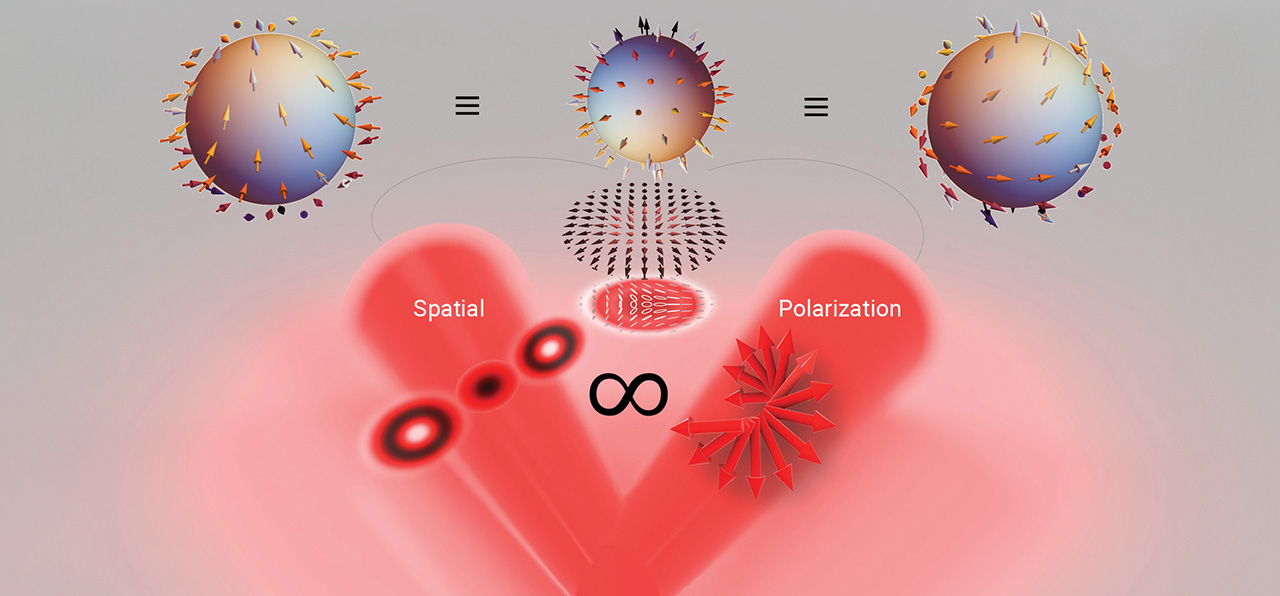 [Enlarge image]Nonlocal quantum light in which two hybrid entangled photons have a shared topology. Smooth deformations do not alter the topology seen in the spheres, which are stereographic projections of the polarization spin vectors representing the joint wavefunction. While they look different, they share the same topological invariant (skyrmion number) and therefore form an equivalence class. Moreover, the joint wavefunction looks identical to a nonseparable vector mode.
[Enlarge image]Nonlocal quantum light in which two hybrid entangled photons have a shared topology. Smooth deformations do not alter the topology seen in the spheres, which are stereographic projections of the polarization spin vectors representing the joint wavefunction. While they look different, they share the same topological invariant (skyrmion number) and therefore form an equivalence class. Moreover, the joint wavefunction looks identical to a nonseparable vector mode.
What aspects of this are topological, and what does this have to do with entanglement? The topological aspect is highlighted by the fact that although smoothly deforming (without tearing) the sphere’s surface may alter the appearance of the spin vectors, it does not change the topological winding number characterizing the structure. This is analogous to performing a smooth deformation on the entangled state, altering it in a way that preserves the topological invariant—in the same way that, in the commonly cited example, morphing a mug into a donut preserves the topological invariant of the number of holes.
Classical and quantum states of light, customized in spatial and polarization degrees of freedom, are paving the way for new and intriguing research avenues.
This principle implies that the entanglement between the two photons can be modified, or their wavefunctions perturbed, without affecting the shared topology. Such robustness suggests that topological characteristics might be maintained even while the entanglement within the system is subject to change, opening up exciting avenues for preserving information and robust quantum communication against certain perturbations. Even more fascinating is that numerous additional topological features of vector modes can be transferred in a similar manner—illustrating, yet again, the synergy between classical and quantum optics.
A rich tapestry to explore
Classical and quantum states of light, customized in spatial and polarization degrees of freedom, are paving the way for new and intriguing research avenues. They are advancing novel encoding schemes with added benefits, thanks to the analogies of entangled states that can exist between them—even though those states differ in fundamental ways. With the expanding toolbox for tailoring such structured fields, both quantum and classical, new frontiers will be reached. The rich tapestry resulting from this synergy has yet to be fully explored.
Acknowledgements: The author thanks Andrew Forbes for discussions and advice and Pedro Ornelas and Cade Peters for contributing to the figures.
Isaac Nape is the Optica Emerging Leader in Optics Chair in the Structured Light Laboratory, University of the Witwatersrand, South Africa.
For references and resources, visit optica-opn.org/link/0524-light-states.
